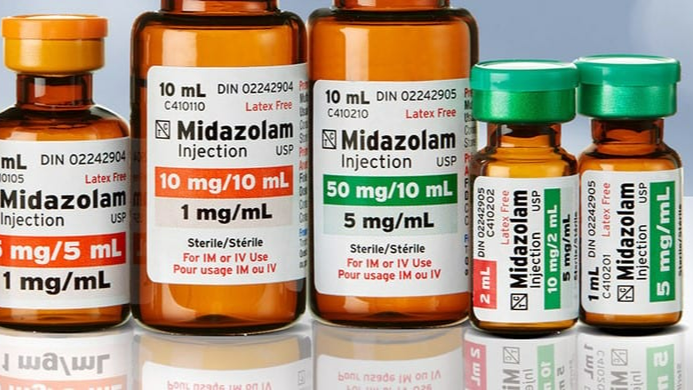Today in this article we will look at the drugs that are used for conscious sedation in pediatric patients.
Opioids
Morphine, Meperidine and Fentanyl are the opiods that are used for moderate sedation. Opiods produces sedation and analgesia and cause respiratory depression.
Morphine:
- It produces sedation, analgesia and mood alteration.
- On set of action - 5 minutes for IV doses and 15 min for IM,
- Peak effect of morphine is 20min(IV) and 1h (IM)
- Duration of action - 3-4 hours
The following are the adverse effects of Morphone:
- Prolonged postoperative somnolence
- Respiratory depression, Hypotension
- Nausea, Vomiting and Itching.
Meperidine:
- It is 1/10th as potent as morphine.
- It is a synthetic opioid with atropine - like properties.
- Onset of action - 3-4 minutes(IV) and 10-15 minutes (IM)
- The peak effect - 15 min (IV) and 45 min (IM)
- Duration of action - 2-4 hours
- Adverse Effects: Hypotension, Bradycardea, respiratory depression, nausea, vomiting, constipation, biliary spasm, and skin rash.
Fentanyl
- It has more rapid onset and shorter duration than morphine
- 100 times more potent than morphine.
- Onset of action - 30 sec(IV) and 5-10 min(IM)
- Peak Effects - 10 mins(IV) and 30-45 mins(IM)
- Duration of action - 30-60 mins
- Fentanyl when given rapidly IV in moderate doses of 2-10 ug/kg or higher doses can produce skeletal muscle rigidly called "stiff chest syndrome".
- Adverse Effects: Hypotension, bradycardia, respiratory depression, nausea, vomiting, constipation, biliary spasm, and skin rash.
Benzodiazepines
- These are group of medications most commonly used for moderate sedation.
- These drugs produces amnesia, anxiolytic, anticonculsive and hypmotic effects.
- Commonly used benzodiazepines for moderate sedation are Diazepam, Lorazepam, Midazolam.
Diazepam / Lorazepam
- These drugs have similar profiles.
- Lorazepam have similar duration or action but is five times more potent on diazepam.
- Diazepam can cause mild reductions in blood pressure, cardiac output and peripheral vascular resistance.
Midazolam
- Generally used for anxious adolsescent or adult dental patient.
- It can cause disinhibition rather than sedation in children.
- High lipophilicity at physiological PH.
- Due to its high clearance and elimination it has rapid onset of action and speedy recovery.

Intravenous Midazolam
- Used widely in adults. Few studies support its dental use in the dental management of anxious children.
- It can cause a "paradoxical excitement" in children which is known as "Angry child syndrome".
Oral Midazolam
- Admimistered in tablet form or as sweetened mixture.
- Tablets are given 60 minutes before dental treatment and oral mixtures given approximately 20-30 minutes before.
- It reaches the systematic circulation via the portal circulation and this decreases drug's bioavailability.
- Midazolam is rapidly absorbed in the gastrointestinal tract and produces its peak effect in 30 mins.
- It has short life of about 1.75 hours. So, it is used limited to short dental procedures only.
- When given in doses between 0.5 and 0.75 mg/kg of body weight, oral midazolam has been found to be a useful sedative agent for pediatric dental outpatients.
Intranasal Midazolam
- Produces its sedative effect within 5 minutes of administration.
- Intranasal midazolam may be given at dose of 0.2 - 0.4 mg/kg.
- The dose adminstered is limited by the volume of the solution, as large volumes can cause coughing, sneezing and expulsion of part of the drug.
- Also have been reported of respiratory depression and transient burning, discomfort affecting the nasal mucosa.
- It is not recommended in children who have copious nasal seduction or children suffering from an upper respiratory tract infection.
Barbiturates:
- These drugs result in a central nervous system (CNS) depression by acting at the gamma- aminobutyric acid (GABA) receptor.
- These are usually used for deep sedation.
- drugs commonly used are as follows: Methohexital, Pentobarbital
Methohexical
- It is an ultra short acting barbiturates with rapid onset.
- IV doses of 0.75 - 1 mg/kg produces a sleep like state without spontaneous movement within 1 min.
- Methohexical is irreversible.
- Adverse effects
- Heightened airway reflexes
- Myocardial depression
- CNS and respiratory depression
- Nausea, vomiting, diarrhea, cramping.
Pentobarbital:
- Short-acting barbiturate.
- It is used for non-painful diagnostic studies.
- Dose of 2.5 mg/kg should produce deep sedation within 5 minutes, and effects should last between 30 and 60 minutes.
- Adverse effects
- Hypoxia
- Hypotension
Chloral Hydrate:
- It is a chlorinated derivative of ethyl alcohol which acts as anesthetic when adminstered in high doses.
- Oral choloral hydrate is easy to administer and has low incidence of adverse effect.
- Normal oral dose is 50mg/kg of body weight with a range of 40-60 mg/kg.
- Onset of action of oral chloral hydrate is rapid, within 30-45 minutes.
- Duration of action is 2-5 hours.
- In small doses, mild sedation occurs and, in intermediate doses, natural sleep is produced.
- Adverse effects: Nausea and vomiting, drowsiness, depress blood pressure and respiratory rate.
- It is contraindicated in children with heart disease as well as renal or hepatic impairment.
Ketamine:
- It is a phencyclidine derivative that results in dissociation between the cortical and limbic systems of the brain called dissociative anesthesia.
- Ketamine prevents the higher cortical centers from perceiving visual, auditory and painful stimuli.
- IV dose of 1mg/kg induces sedation in 2 minutes and effects last for 15-30 minutes.
- Ketamine maintains
- Cardiovascular stabilkity
- Muscle tones
- Airway reflexes - Adverse effects:
- Increased intracranial and intraocular pressure
- Hypertension
- Tachycardia
- Postemergence delirium (i.e vivid nightmares)
- Prolonged used may leads to cognitive impairment, including memory problems.
 Trishna Pokhrel
Trishna Pokhrel